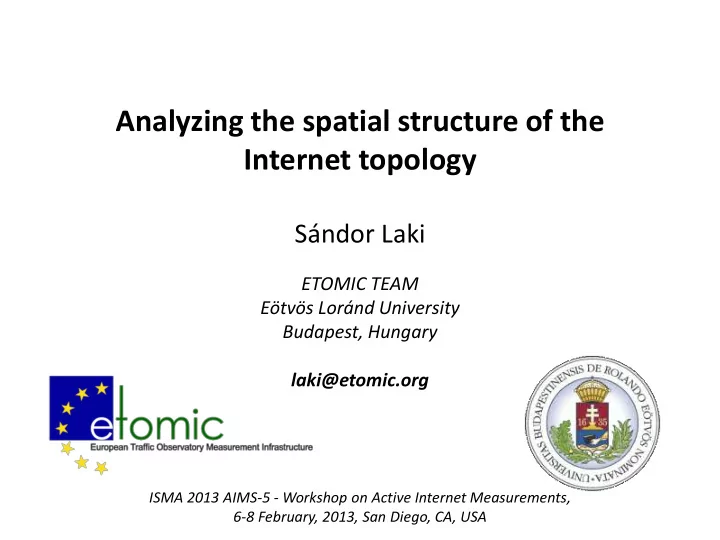

Analyzing the spatial structure of the Internet topology Sándor Laki ETOMIC TEAM Eötvös Loránd University Budapest, Hungary laki@etomic.org ISMA 2013 AIMS-5 - Workshop on Active Internet Measurements, 6-8 February, 2013, San Diego, CA, USA
Network research Erdős and Rényi 1959 Watts and Strogatz 1998 Barabási and Albert 1999
Social Transport Internet Biological
The distance is what really counts.
What can we say about the spatial structure of the Internet? P. Mátray, P. Hága, S. Laki, I. Csabai, G. Vattay On the Spatial Properties of Internet Routes Elsevier Computer Networks, Volume 56, Issue 9 (2012)
Data collection • 700 PlanetLab nodes • 400,000 traceroutes • 16,000 unique IP addresses
?
Data collection 13,000 filtered addresses 44,000 links 5 Spotter S. Laki et al.: Spotter: A Model Based Active Geolocation Service , IEEE INFOCOM 2011, April 2011, Shanghai, China
Router Likelihood map
Characterizing the link length Link length is approximated by the spherical distance between the two routers
Characterizing the network links • Which links are important? • Which cities are the most interconnected? • Which link length is the most frequent? • How to model link length distribution? • What can be said about the spatial structure of the network? • etc.
Which links are frequent or important? LA-Houston • 121,000 occurances • 39 unique links • 1.5% of all traffic! Copenhagen - New York & Paris - Washington each link is represented once links are weighted up with their prevalence in the traceroute data set
Characterizing network paths • Circuitousness • Direction dependence of lateral deviations • Hop distance analysis • Symmetry of Internet routes
Aggregated path length The sum of the length of the consecutive links.
Circuitousness L(P) The spherical distance of the two endpoints Geographic, geopolitical and economical factors also affect routing
Direction dependence of lateral deviations
Data • Our data is freely available • Stored in Network Measurement Virtual Observatory ( NMVO ) – Etomic ’s data sharing platform – Easy-to-use web Interface • to access different data in different databases – Standard SQL queries – Data exportation into CSV and XML – http://nm.vo.elte.hu • Tutorial on getting the data: – http://spotter.etomic.org/routerdata
Data: http://nm.vo.elte.hu
Data Visualization • Quantum GIS – Open source GIS software – with our own preprocessing toolkit • Google Map • iGraph for R
What do we expect from you? • More data – More complete router level topologies – Or other measurements • Collaboration – Please feel free to use our data • http://spotter.etomic.org/routerdata – Measurement agents other than PlanetLab nodes • E.g. in commercial networks – Federating external data sources in NMVO • Unified querying interface • Feedback on our tools – NMVO – A data sharing platform with unified SQL-based querying interface • http://nm.vo.elte.hu – Spotter – An active IP Geolocation service • http://spotter.etomic.org – SONoMA – A Network Measurement Platform • http://sonoma.etomic.org
Thank you Contact: S á ndor Laki laki@etomic.org This work was partially supported by the National Office for Research and Technology (NAP 2005/ KCKHA005) , the EU FP7 OpenLab Integrated Project (Grant No. 287581) and the National Science Foundation OTKA 7779 and 80177.
Recommend
More recommend